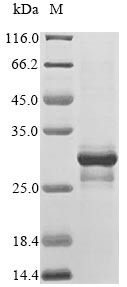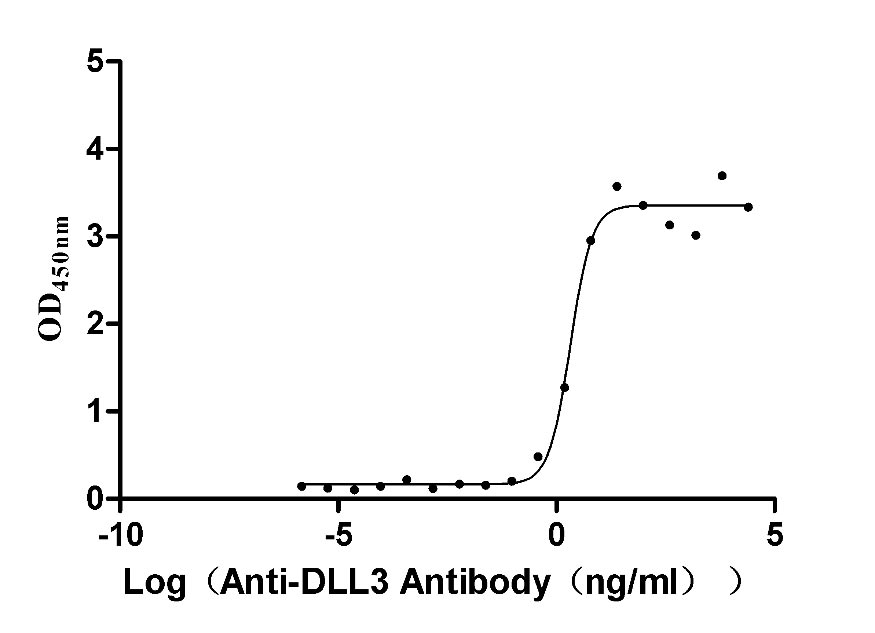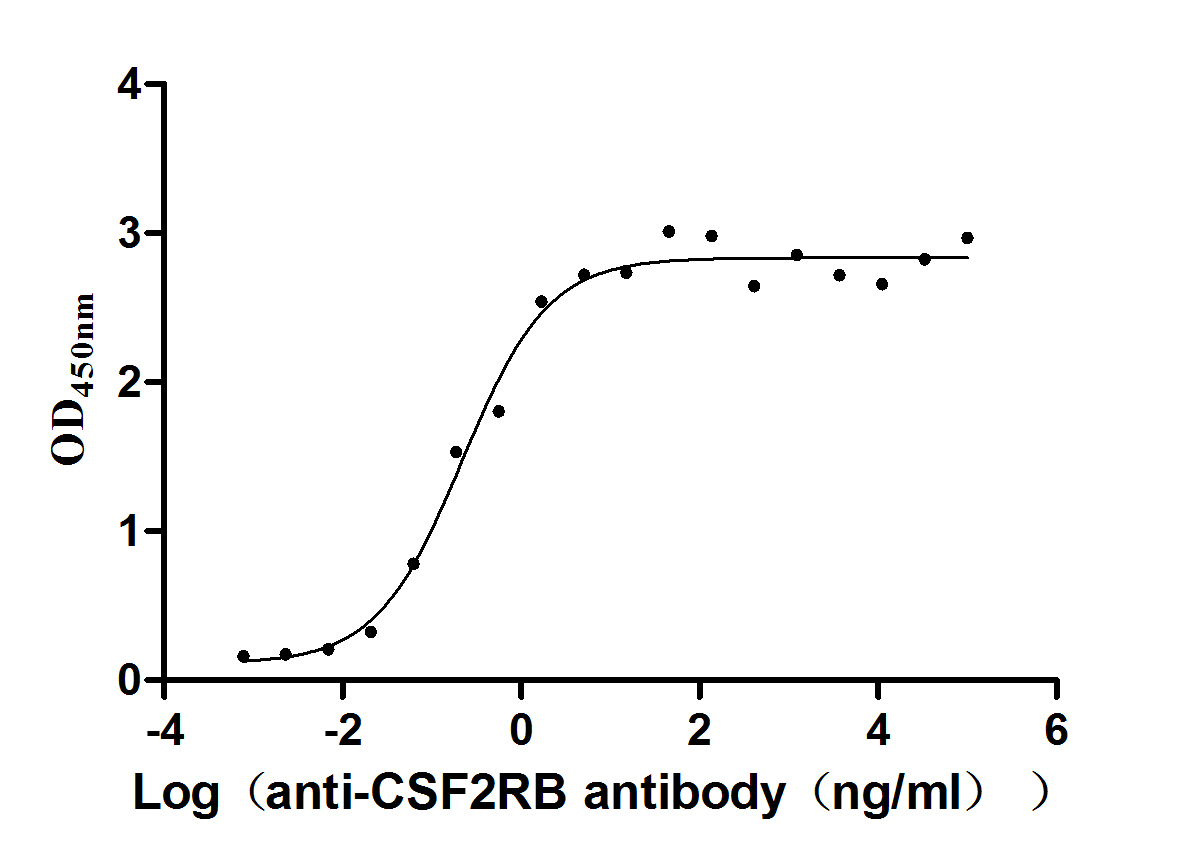Recombinant Human Melanoma antigen recognized by T-cells 1 (MLANA)
In Stock-
中文名称:人MLANA重组蛋白
-
货号:CSB-EP621968HU
-
规格:¥1344
-
图片:
-
其他:
产品详情
-
纯度:Greater than 90% as determined by SDS-PAGE.
-
基因名:
-
Uniprot No.:
-
别名:Antigen LB39 AA; Antigen LB39-AA; Antigen SK29 AA; Antigen SK29-AA; MAR1_HUMAN; MART 1; MART-1; MART1; Melan A; Melan A protein; Melanoma antigen recognized by T cells 1; Melanoma antigen recognized by T-cells 1; MLAN A; MLANA; OTTHUMP00000021036; OTTHUMP00000021037; OTTHUMP00000021038; Protein Melan-A
-
种属:Homo sapiens (Human)
-
蛋白长度:Full Length
-
来源:E.coli
-
分子量:27.2kDa
-
表达区域:1-118aa
-
氨基酸序列MPREDAHFIYGYPKKGHGHSYTTAEEAAGIGILTVILGVLLLIGCWYCRRRNGYRALMDKSLHVGTQCALTRRCPQEGFDHRDSKVSLQEKNCEPVVPNAPPAYEKLSAEQSPPPYSP
Note: The complete sequence including tag sequence, target protein sequence and linker sequence could be provided upon request. -
蛋白标签:N-terminal 6xHis-B2M-tagged
-
产品提供形式:Liquid or Lyophilized powder
Note: We will preferentially ship the format that we have in stock, however, if you have any special requirement for the format, please remark your requirement when placing the order, we will prepare according to your demand. -
缓冲液:Tris-based buffer,50% glycerol
-
储存条件:Store at -20°C/-80°C upon receipt, aliquoting is necessary for mutiple use. Avoid repeated freeze-thaw cycles.
-
保质期:The shelf life is related to many factors, storage state, buffer ingredients, storage temperature and the stability of the protein itself.
Generally, the shelf life of liquid form is 6 months at -20°C/-80°C. The shelf life of lyophilized form is 12 months at -20°C/-80°C. -
货期:3-7 business days
-
注意事项:Repeated freezing and thawing is not recommended. Store working aliquots at 4°C for up to one week.
-
Datasheet & COA:Please contact us to get it.
相关产品
靶点详情
-
功能:Involved in melanosome biogenesis by ensuring the stability of GPR143. Plays a vital role in the expression, stability, trafficking, and processing of melanocyte protein PMEL, which is critical to the formation of stage II melanosomes.
-
基因功能参考文献:
- Melan-A-stained slides shows definitive invasion. PMID: 27533878
- Report automated quantification of proliferation with automated hot-spot selection in phosphohistone H3/MART1 dual-stained stage I/II melanoma. PMID: 27062658
- Suggest MelanA-negative spindle-cell associated melanoma constitutes a distinct inflammatory phenotype correlated with dense infiltration of CD163 macrophages and loss of E-cadherin. PMID: 25602697
- Inhibin alpha-subunit, Melan A and MNF116 were not sensitive for pheochromocytomas. PMID: 25329118
- the presence of antibody and T-cell immune responses directed against the melanocyte-differentiation-antigens MART-1 (Melan-A), tyrosinase and gp100 in patients with melanoma-associated leucoderma, as compared to patients with vitiligo. PMID: 25043574
- Knockdown of T-bet expression in Mart-127-35 -specific T-cell-receptor-engineered human CD4(+) CD25(-) and CD8(+) T cells attenuates effector function. PMID: 25495780
- Melan-A was useful to confirm the diagnosis of lentigo maligna in early lesions and to differentiate these from chronically sun-damaged skin. PMID: 24394300
- Misinitiation of intrathymic MART-1 transcription and biased TCR usage explain the high frequency of MART-1-specific T cells. PMID: 24846220
- Comprehensive characterization of the marginal and joint distributions for S100, HMB-45, and Melan-A across a large series of cutaneous melanomas revealed diversity of expression across this group of antigens. PMID: 23899062
- melan A (A103) is not expressed in mesotheliomas PMID: 22820661
- Report diagnostic role of immunohistochemical staining for Melan-A in evaluating primary melanoma and, specifically, in situ melanoma cases. PMID: 22688397
- In this study, production of the C terminus of the Melan-A(26-35) epitope requires cleavage within a hydrophobic stretch, after V35. Hence, the standard proteasome is the only proteasome able to produce the C terminus of this epitope. PMID: 22925930
- naturally occurring MART-1 melanoma antigen can be taken-up from dying melanoma cells into DC or MAK and both cell types can induce specific CD8(+) T cell cross-presentation thereafter. PMID: 22768350
- The presence of circulating T cells responding to Melan-A or NY-ESO-1 had strong independent prognostic impact on survival in advanced melanoma. PMID: 22529253
- The modified melan-A long peptides (not their wild-type counterparts) give rise to highly sustained cross-presentation capacity by monocyte-derived dendritic cells and could be used as tumor vaccines for treatment of melanoma patients. PMID: 22291187
- Aberrant expression of Melan-A and MART-1 in AFX and undifferentiated pleomorphic sarcoma of the skin represents an important diagnostic pitfall with potential for misdiagnosis as melanoma. PMID: 22050092
- MART-1- and gp100-expressing and -non-expressing melanoma cells are equally proliferative in tumors and clonogenic in vitro. PMID: 21993558
- we established several CD4 T-cell clones that recognized a peptide that is embedded within Melan-A/MART-121-50, in a HLA-DPB1*0501 restricted manner PMID: 21760531
- Melanocyte MART-1 may correlate to the autoimmune mechanism in children with vitiligo. PMID: 19861278
- The differential expression of Mart-1 was investigated in four human uveal melanoma cells. PMID: 21667026
- Translocation of the BCL2 gene on the chromosome band 18q21.3 and MYC translocation to 14q32/IGH or less commonly to 2p11/IGK in an identical cell is termed BCL2 and MYC dual-hit lymphoma/leukemia PMID: 21362015
- Both semiscale and fullscale quantitative analyses of Ki67/MART1 stains are valuable diagnostic tools to distinguish melanomas and nevi with a large degree of certainty. PMID: 21610457
- Molecular upstaging of MART-1 using rt-pcr was correlated with prognosis in melanoma patients PMID: 21135695
- determined the crystal structure of a phosphopeptide derived from melanoma antigen recognized by T cells-1 (pMART-1), selectively expressed by melanomas, in complex with HLA-DR1 PMID: 20417641
- OA1 interacts with MART-1 at early stages of melanogenesis to control melanosome identity and composition. PMID: 19717472
- unexpected high frequency of T cells specific for the self-antigen Melan-A/MART-1 in CD8 single-positive thymocytes from human histocompatibility leukocyte antigen-A2 healthy individuals PMID: 11854361
- Melanosomes from an Achilles tendon clear-cell sarcoma showed expression of the Melan-A gene. PMID: 12072203
- The high frequency of Melan-A multimer(+) T cells can be explained by the existence of largely cross-reactive subsets of naive CD8(+) T cells displaying multiple specificities. PMID: 12119345
- dominant function of TCRAV2 segment in forming the TCR repertoire specific for the human self Ag Melan-A/MART-1 PMID: 12444131
- Data show that MITF appears to regulate the expression of the SILV and MLANA genes. PMID: 12819038
- Antigen-specific T lymphocyte reactivity to MelanA/MART-1 and tyrosinase peptides was not observed ex vivo in our vitiligo patients, and only one patient demonstrated responses to MelanA/MART-1 PMID: 12925214
- adrenocortical neoplasms showed strong and diffuse granular cytoplasmic staining for Melan A. No nuclear reaction was observed. PMID: 14663359
- the expression of Melan-A/MART-1 in patient-derived cell cultures may help to identify a group of melanoma patients with prolonged survival PMID: 15305155
- Melan-A is very useful in distinguishing between desmoplastic melanoma and sclerotic nevi. PMID: 15618925
- Data suggest that MART-1 is indispensable for Pmel17 function and thus plays an important role in regulating mammalian pigmentation. PMID: 15695812
- Two new Melan-A-derived CD4+ T cell epitopes have been identified that map to the 1-20 and 91-110 regions of the protein and are restricted by HLA-DR11 and HLA-DR52 molecules. PMID: 16814609
- Blocking MAPK signaling augments antigen levels, thereby enhancing Melan-A/MART-1-specific cytotoxic T-cell responses to antigen-negative cells following MEK inhibition treatment. PMID: 17050671
- Two novel Melan-A/MART-1-derived sequences recognized by CD4 T cells from melanoma patients provide the basis for monitoring of naturally occurring and vaccine-induced Melan-A/MART-1-specific CD4 T cell responses. PMID: 17082590
- HMB-45 and Melan-A combined were positive in 100% of the renal angiomyolipomas. PMID: 17227112
- Data show that the MAT-1 26-35 and 27-35 peptides adopt strikingly different conformations when bound to HLA-A2. PMID: 17719062
- t cell recaptor antigens and the major histocompatibilyt complex are complexed with this protein. PMID: 17768347
- the combinational characterization of calretinin (either by polyclonal or monoclonal antibody), inhibin alpha, and Melan-A expression is of great significance in the differential diagnosis of adrenocortical tumors. PMID: 18091323
- these data significantly enlarge the fraction of melanoma patients susceptible to benefit from a Melan-A/MART1 vaccine approach. PMID: 18097665
- Measurement of Melan-A, gp100, MAGE-3, MIA and tyrosinase represents a prognostic factor and a method for early detection of metastasis and treatment response of melanoma patients. PMID: 18181974
- Although melan-A-specific T cells were detectable, they are unlikely to be involved in the etiopathogenesis of vitiligo. PMID: 18337837
- Increased staining with Melan-A, in an actinic keratosis, or solar lentigo should raise the possibility of a contiguous melanoma in situ. PMID: 18494818
- results show a complex pattern of changes in the expression of Melan-A in melanomas depending on the location of melanoma cells within individual skin layers PMID: 18626310
- the generation of larger numbers of ELAGIGILTV ((MART-1 26-35, A27L)-specific CD8+ T cells correlates negatively with the acquisition of a CD45RA+CCR7- phenotype and cytotoxic capacity. PMID: 19050104
- T-cell receptor beta chain sequences of Melan-A-specific clonotypes obtained from melanoma patients were highly heterogeneous, but displayed a preferential usage of few TRBV and TRBJ segments. PMID: 19317896
- Case Report: Melan-a-positive "pseudomelanocytic nests": a pitfall in the histopathologic and immunohistochemical diagnosis of pigmented lesions on sun-damaged skin. PMID: 19384076
显示更多
收起更多
-
亚细胞定位:Endoplasmic reticulum membrane; Single-pass type III membrane protein. Golgi apparatus. Golgi apparatus, trans-Golgi network membrane. Melanosome. Note=Also found in small vesicles and tubules dispersed over the entire cytoplasm. A small fraction of the protein is inserted into the membrane in an inverted orientation. Inversion of membrane topology results in the relocalization of the protein from a predominant Golgi/post-Golgi area to the endoplasmic reticulum. Melanoma cells expressing the protein with an inverted membrane topology are more effectively recognized by specific cytolytic T-lymphocytes than those expressing the protein in its native membrane orientation.
-
组织特异性:Expression is restricted to melanoma and melanocyte cell lines and retina.
-
数据库链接:
HGNC: 7124
OMIM: 605513
KEGG: hsa:2315
STRING: 9606.ENSP00000370880
UniGene: Hs.154069
Most popular with customers
-
Recombinant Macaca fascicularis Delta-like protein 3 (DLL3), partial (Active)
Express system: Mammalian cell
Species: Macaca fascicularis (Crab-eating macaque) (Cynomolgus monkey)
-
Recombinant Human Poliovirus receptor (PVR) (I340M), partial (Active)
Express system: Mammalian cell
Species: Homo sapiens (Human)
-
Recombinant Human Cytokine receptor common subunit beta (CSF2RB), partial (Active)
Express system: Mammalian cell
Species: Homo sapiens (Human)
-
Recombinant Mouse Retinol-binding protein 4 (Rbp4) (Active)
Express system: Mammalian cell
Species: Mus musculus (Mouse)
-
Recombinant Human Claudin-9 (CLDN9)-VLPs (Active)
Express system: Mammalian cell
Species: Homo sapiens (Human)
-
Recombinant Human Lymphocyte antigen 6 complex locus protein G6d (LY6G6D) (Active)
Express system: Yeast
Species: Homo sapiens (Human)
-
Recombinant Mouse Gastric inhibitory polypeptide receptor (Gipr), partial (Active)
Express system: Mammalian cell
Species: Mus musculus (Mouse)
-
Recombinant Human Cytotoxic and regulatory T-cell molecule (CRTAM), partial (Active)
Express system: Mammalian cell
Species: Homo sapiens (Human)




-AC1.jpg)
















